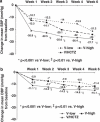Effectiveness of initiating treatment with valsartan/hydrochlorothiazide in patients with stage-1 or stage-2 hypertension
- PMID: 20010618
- PMCID: PMC2898539
- DOI: 10.1038/jhh.2009.90
Effectiveness of initiating treatment with valsartan/hydrochlorothiazide in patients with stage-1 or stage-2 hypertension
Abstract
This prospective, 6-week, multicenter, double-blind study examined the benefits of initiating treatment with combination valsartan/hydrochlorothiazide (HCTZ) compared with initial valsartan monotherapy for 648 patients with stage-1 or stage-2 hypertension (age=52.6+/-10 years; 54% male; baseline blood pressure (BP)=161/98 mm Hg, 32% stage 1). Patients were randomized to valsartan 80 mg (V-low), valsartan 160 mg (V-high) or valsartan/HCTZ 160/12.5 mg (V/HCTZ), and electively titrated after weeks 2 and 4 to the next dosage level (maximum dose valsartan/HCTZ 160/25 mg) if BP remained >140/90 mm Hg. At end of the study, patients initiated with V/HCTZ required less titration steps compared with the initial valsartan monotherapy groups (63 vs 86% required titration by study end, respectively) and reached the target BP goal of <140/90 mm Hg in a shorter period of time (2.8 weeks) (P<0.0001) vs V-low (4.3 weeks) and V-high (3.9 weeks). Initial combination therapy was also associated with higher BP control rates and greater reductions in both systolic and diastolic BP from baseline (63%, -27.7+/-13/-15.1+/-8 mm Hg) compared with V-low (46%, -21.2+/-13/-11.4+/-8 mm Hg, P<0.0001) or V-high (51%, -24.0+/-13/-12.0+/-10 mm Hg, P<0.01). Overall and drug-related AEs were mild to moderate and were similar between V/HCTZ (53.1 and 14.1%, respectively) and the two monotherapy groups, V-low (50.5 and 13.8%) and V-high (50.7 and 11.8%). In conclusion, initiating therapy with a combination of valsartan and low-dose HCTZ results in early, improved BP efficacy with similar tolerability as compared with starting treatment with a low or higher dose of valsartan for patients with stage-1 and stage-2 hypertension.
Trial registration: ClinicalTrials.gov NCT00280540.
Figures





Similar articles
-
Efficacy and tolerability of combination therapy with valsartan plus hydrochlorothiazide compared with amlodipine monotherapy in hypertensive patients with other cardiovascular risk factors: the VAST study.Clin Ther. 2005 May;27(5):578-87. doi: 10.1016/j.clinthera.2005.05.006. Clin Ther. 2005. PMID: 15978306 Clinical Trial.
-
Tolerability and blood pressure-lowering efficacy of the combination of amlodipine plus valsartan compared with lisinopril plus hydrochlorothiazide in adult patients with stage 2 hypertension.Clin Ther. 2007 Feb;29(2):279-89. doi: 10.1016/j.clinthera.2007.02.003. Clin Ther. 2007. PMID: 17472820 Clinical Trial.
-
Antihypertensive efficacy and tolerability of two fixed-dose combinations of valsartan and hydrochlorothiazide compared with valsartan monotherapy in patients with stage 2 or 3 systolic hypertension: an 8-week, randomized, double-blind, parallel-group trial.Clin Ther. 2005 Jul;27(7):1013-21. doi: 10.1016/j.clinthera.2005.07.010. Clin Ther. 2005. PMID: 16154480 Clinical Trial.
-
Efficacy and tolerability of combination therapy with valsartan/hydrochlorothiazide in the initial treatment of severe hypertension.Curr Med Res Opin. 2008 Aug;24(8):2303-11. doi: 10.1185/03007990802271946. Epub 2008 Jun 28. Curr Med Res Opin. 2008. PMID: 18593517 Clinical Trial.
-
Amlodipine/valsartan single-pill combination: a review of its use in the management of hypertension.Am J Cardiovasc Drugs. 2009;9(5):309-30. doi: 10.2165/11201120-000000000-00000. Am J Cardiovasc Drugs. 2009. PMID: 19791840 Review.
References
-
- Ong KL, Cheung BM, Man YB, Lau CP, Lam KS. Prevalence, awareness, treatment, and control of hypertension among United States adults 1999–2004. Hypertension. 2007;49:69–75. - PubMed
-
- Dahlöf B, Sever PS, Poulter NR, Wedel H, Beevers DG, Caulfield M, for ASCOT Investigators et al. Prevention of cardiovascular events with an antihypertensive regimen of amlodipine adding perindopril as required versus atenolol adding bendroflumethiazide as required, in the Anglo-Scandinavian Cardiac Outcomes Trial-Blood Pressure Lowering Arm (ASCOT-BPLA): a multicentre randomized controlled trial. Lancet. 2005;366:895–906. - PubMed
-
- Okonofua EC, Simpson KN, Jesri A, Rehman SU, Durkalski VL, Egan BM. Therapeutic inertia is an impediment to achieving the Healthy People 2010 blood pressure control goals. Hypertension. 2006;47:345–351. - PubMed
-
- Calhoun DA, Glazer RD, Pettyjohn FS, Coenen PD, Zhao Y, Grosso A. Efficacy and tolerability of combination therapy with valsartan/hydrochlorothiazide in the initial treatment of severe hypertension. Curr Med Res Opin. 2008;24:2303–2311. - PubMed

